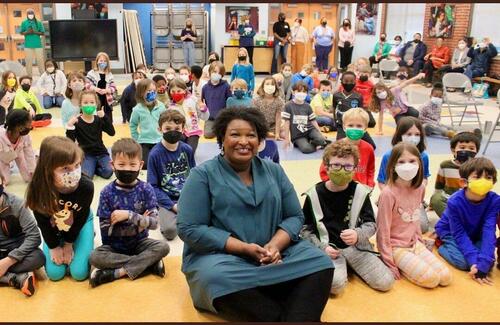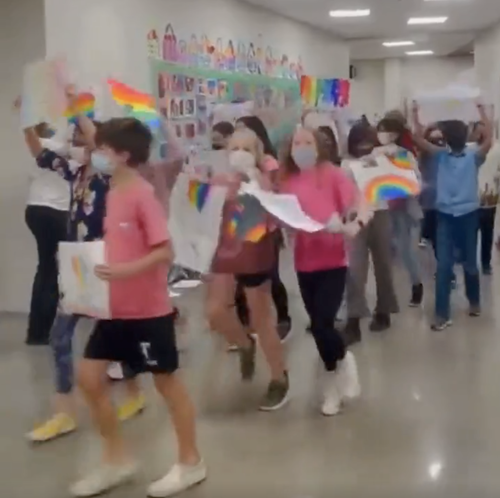
Authored by Brian McGlinchey via starkrealities.substack.com
Since the beginning of the Covid-19 pandemic, America’s parents have shifted nearly 2 million students from public schools to alternatives that include private schools and home schooling. For public schools, that represents a loss of about 4% of their enrollment.
Expect the exodus to grow larger, as the United States is undergoing a major change in philosophy regarding publicly-funded K-12 education, away from funding government-run school systems and toward funding individual students—with parents getting to choose where their children learn.
In June, Arizona put itself at the leading edge of that shift: Every Arizona family can now direct about $7,000 a year per student toward the education solution of their choice. Funds can be used for private schools, home schooling, tutoring and online learning.

Arizona also provides free choice among public schools — rather than being forced into a particular school by neighborhood, parents who prefer public schools can pick whichever one they want, first-come first-served.
Defenders of the status quo typically characterize school-choice laws as “taking money away” from public schools, recoiling at the very idea that government money would be spent anywhere other than a government institution.
However, that’s already how the great majority of publicly-funded education and other entitlements work, without uproar.
“We have Pell Grants for low-income students for higher eduction, we have the Head Start program for pre-K where you can pick public, private, religious or non-religious,” said Corey DeAngelis, a senior fellow at the American Federation for Children, on Michael Malice’s “Your Welcome” podcast.
“We have food stamps where the money goes to the person and you can pick Walmart or Trader Joe’s…it doesn’t go to a residentially-assigned, government-run grocery store. That would be absolutely ridiculous.”
Meanwhile, those who say school choice programs will drain public schools of huge sums of money are implicitly asserting that, were it not for a system that protects public schools from competition — by granting them a monopoly on the use of public K-12 funds — a great many more parents would send their children elsewhere.
For decades, public school monopolies have been protected by a particular, self-reinforcing power dynamic:
-
Powerful teacher unions overwhelmingly favor Democratic politicians. Exhibit A: Democrats have received 99.94% of congressional contributions from the American Federation of Teachers in 2022.
-
Democratic politicians protect public school monopolies by opposing voucher and other school choice programs, while relentlessly pushing for increased public school funding
-
Increased funding enables the hiring of more public school staff
-
Larger staffs mean more union dues, enriching teacher unions and increasing their political power…and the cycle repeats
Today, however, there are large cracks in the foundation of this monopoly-protecting fortress, and the government response to the Covid-19 pandemic has been a big factor.
With public schools closed to in-person instruction, parents were suddenly much more engaged in their children’s education, and many didn’t like what they were seeing as they observed remote teaching.
As the pandemic ground on, relentless union opposition to school re-openings, and the insistence on masking children despite the many collateral harms of doing so, made it all too clear to enlightened parents that public teacher unions — and public school boards — can’t be trusted to always put children’s interests first.

Though the government’s destructive responses to the pandemic are now largely behind us, the impact on parent attitudes about public schools is still growing, as a steady stream of reports illuminates the massive learning setbacks experienced by K-12 victims of school shutdowns.
At the same time, new data shows that students in private schools — which were much more eager to provide in-person instruction — fared significantly better.
The ongoing culture wars are another reason more people are embracing the idea of funding students rather than systems.
Parents understandably have strongly differing ideas about what’s appropriate for the classroom. Rather than forcing opposing parents into the same school and having them fight at board meetings about which curriculum will be forced onto everyone, each family should be free to seek out a school arrangement that best matches their own philosophy — and use public money to do so.

Many politicians who oppose school choice are themselves private school products or send their own children to private schools. One of the most notorious such hypocrites is Democratic Senator Elizabeth Warren.
Pandering to teacher unions as a presidential candidate, Warren said she not only wanted to stop school choice programs, but also end federal funding for charter schools and make it harder to open new ones.
Yet Warren sent her son to private schools — including one on Philadelphia’s wealthy Main Line where total fees today are $42,600. Worse, she actually denied it when confronted about her hypocrisy by a group of black Atlanta activists, who know the worst-performing public schools tend to be in poor, minority communities — and that wealthier people like Warren have the disposable income to afford private schools without using government money.
Nebraska state senator Justin Wayne, a black Democrat who supports school choice, knows all that too. Wayne told his colleagues he’d vote against school choice if they moved their children to a school in his neighborhood “so we can go through the transformation — that you keep telling my community to wait for — together.”
BREAKING: Nebraska Senator Justin Wayne (D) again calls out his colleagues for sending their kids to private school while opposing school choice for others. pic.twitter.com/WiXAmcBRN8
— Corey A. DeAngelis (@DeAngelisCorey) January 11, 2022
Arizona’s 2022 expansion is distinguished from other school-choice experiments by its universality — all children are eligible to use a stipulated amount of state school dollars for education at a public school, private school or home school, regardless of where they live or the incomes of their parents.
Having witnessed what Arizona has done, activist parents in other states are now pressuring their own legislatures. As they do, they’re backed by polls showing 72% of Americans now support school choice programs, including 82% of Republicans and 68% of Democrats.
Look for the school choice movement to take a major step forward in 2023 — most impactfully in Texas. The Lone Star State’s public school population is a close second in size to California’s, and nearly double the third largest, which is Florida’s.
In the wake of Arizona’s school choice expansion, Governor Greg Abbott said he too wants to let parents “send their children to any public school, charter school or private school with state funding following the student,” and the next biennial legislature section starts on Jan. 10.
While private school enrollments will surge, the rise of school choice will also stimulate a novel education approach that existed before the pandemic but was greatly popularized by it — learning pods.
When parents were let down by public school closures — with working parents suddenly scrambling to manage day-long supervision of their children — many of them formed collaborative learning pods, where small groups of children would gather at a single home to do schoolwork together and have social interaction.
Before the pandemic, other parents had already used a pod approach to home-schooling. As school choice programs allow the use of state money to cover the cost of home schooling, look for pods to proliferate.
Those pods won’t all be led by parents. The concept could turn into an ideal career alternative for public school teachers yearning to break free from public school system bureaucracy.
Consider the math in Arizona for a former public school teacher who sets out on her own and assembles a pod of 15 children to teach. With parents able to tap up to about $7,000 per student per year for education, that teacher could charge $105,000 for her services with no out-of-pocket expense for the parents. In 2021, public school teacher salaries in Arizona ranged between $40,554 and $68,910.
Particularly for middle and high schools, where deeper subject-matter knowledge is required, groups of specialist teachers could collaborate to form their own “micro-schools.”
Of course, when comparing income, teachers will have to factor in expenses and the loss of public school system employee benefits — as well as intangible changes in quality-of-life they realize by leaving a public school system behind.
Parents will have their own pros and cons to consider, which is one reason why school choice shouldn’t be equated with the wholesale destruction of public schools. Indeed, it’s likely to bring about long-needed improvements — especially when programs like Arizona’s let parents who stay in the public system choose which public school their child attends.
“Twenty-five of 27 studies suggest that…school-choice competition leads to better outcomes in the public schools,” said DeAngelis. “Why? Because school choice is a rising tide that lifts all boats. Competition works.”
* * *
Stark Realities undermines official narratives, demolishes conventional wisdom and exposes fundamental myths across the political spectrum. Read more and subscribe at starkrealities.substack.com
Stark Realities: Invigoratingly unorthodox perspectives for intellectually honest readers
Authored by Brian McGlinchey via starkrealities.substack.com
Since the beginning of the Covid-19 pandemic, America’s parents have shifted nearly 2 million students from public schools to alternatives that include private schools and home schooling. For public schools, that represents a loss of about 4% of their enrollment.
Expect the exodus to grow larger, as the United States is undergoing a major change in philosophy regarding publicly-funded K-12 education, away from funding government-run school systems and toward funding individual students—with parents getting to choose where their children learn.
In June, Arizona put itself at the leading edge of that shift: Every Arizona family can now direct about $7,000 a year per student toward the education solution of their choice. Funds can be used for private schools, home schooling, tutoring and online learning.

Arizona also provides free choice among public schools — rather than being forced into a particular school by neighborhood, parents who prefer public schools can pick whichever one they want, first-come first-served.
Defenders of the status quo typically characterize school-choice laws as “taking money away” from public schools, recoiling at the very idea that government money would be spent anywhere other than a government institution.
However, that’s already how the great majority of publicly-funded education and other entitlements work, without uproar.
“We have Pell Grants for low-income students for higher eduction, we have the Head Start program for pre-K where you can pick public, private, religious or non-religious,” said Corey DeAngelis, a senior fellow at the American Federation for Children, on Michael Malice’s “Your Welcome” podcast.
“We have food stamps where the money goes to the person and you can pick Walmart or Trader Joe’s…it doesn’t go to a residentially-assigned, government-run grocery store. That would be absolutely ridiculous.”
Meanwhile, those who say school choice programs will drain public schools of huge sums of money are implicitly asserting that, were it not for a system that protects public schools from competition — by granting them a monopoly on the use of public K-12 funds — a great many more parents would send their children elsewhere.
For decades, public school monopolies have been protected by a particular, self-reinforcing power dynamic:
-
Powerful teacher unions overwhelmingly favor Democratic politicians. Exhibit A: Democrats have received 99.94% of congressional contributions from the American Federation of Teachers in 2022.
-
Democratic politicians protect public school monopolies by opposing voucher and other school choice programs, while relentlessly pushing for increased public school funding
-
Increased funding enables the hiring of more public school staff
-
Larger staffs mean more union dues, enriching teacher unions and increasing their political power…and the cycle repeats
Today, however, there are large cracks in the foundation of this monopoly-protecting fortress, and the government response to the Covid-19 pandemic has been a big factor.
With public schools closed to in-person instruction, parents were suddenly much more engaged in their children’s education, and many didn’t like what they were seeing as they observed remote teaching.
As the pandemic ground on, relentless union opposition to school re-openings, and the insistence on masking children despite the many collateral harms of doing so, made it all too clear to enlightened parents that public teacher unions — and public school boards — can’t be trusted to always put children’s interests first.

Though the government’s destructive responses to the pandemic are now largely behind us, the impact on parent attitudes about public schools is still growing, as a steady stream of reports illuminates the massive learning setbacks experienced by K-12 victims of school shutdowns.
At the same time, new data shows that students in private schools — which were much more eager to provide in-person instruction — fared significantly better.
The ongoing culture wars are another reason more people are embracing the idea of funding students rather than systems.
Parents understandably have strongly differing ideas about what’s appropriate for the classroom. Rather than forcing opposing parents into the same school and having them fight at board meetings about which curriculum will be forced onto everyone, each family should be free to seek out a school arrangement that best matches their own philosophy — and use public money to do so.

Many politicians who oppose school choice are themselves private school products or send their own children to private schools. One of the most notorious such hypocrites is Democratic Senator Elizabeth Warren.
Pandering to teacher unions as a presidential candidate, Warren said she not only wanted to stop school choice programs, but also end federal funding for charter schools and make it harder to open new ones.
Yet Warren sent her son to private schools — including one on Philadelphia’s wealthy Main Line where total fees today are $42,600. Worse, she actually denied it when confronted about her hypocrisy by a group of black Atlanta activists, who know the worst-performing public schools tend to be in poor, minority communities — and that wealthier people like Warren have the disposable income to afford private schools without using government money.
Nebraska state senator Justin Wayne, a black Democrat who supports school choice, knows all that too. Wayne told his colleagues he’d vote against school choice if they moved their children to a school in his neighborhood “so we can go through the transformation — that you keep telling my community to wait for — together.”
BREAKING: Nebraska Senator Justin Wayne (D) again calls out his colleagues for sending their kids to private school while opposing school choice for others. pic.twitter.com/WiXAmcBRN8
— Corey A. DeAngelis (@DeAngelisCorey) January 11, 2022
Arizona’s 2022 expansion is distinguished from other school-choice experiments by its universality — all children are eligible to use a stipulated amount of state school dollars for education at a public school, private school or home school, regardless of where they live or the incomes of their parents.
Having witnessed what Arizona has done, activist parents in other states are now pressuring their own legislatures. As they do, they’re backed by polls showing 72% of Americans now support school choice programs, including 82% of Republicans and 68% of Democrats.
Look for the school choice movement to take a major step forward in 2023 — most impactfully in Texas. The Lone Star State’s public school population is a close second in size to California’s, and nearly double the third largest, which is Florida’s.
In the wake of Arizona’s school choice expansion, Governor Greg Abbott said he too wants to let parents “send their children to any public school, charter school or private school with state funding following the student,” and the next biennial legislature section starts on Jan. 10.
While private school enrollments will surge, the rise of school choice will also stimulate a novel education approach that existed before the pandemic but was greatly popularized by it — learning pods.
When parents were let down by public school closures — with working parents suddenly scrambling to manage day-long supervision of their children — many of them formed collaborative learning pods, where small groups of children would gather at a single home to do schoolwork together and have social interaction.
Before the pandemic, other parents had already used a pod approach to home-schooling. As school choice programs allow the use of state money to cover the cost of home schooling, look for pods to proliferate.
Those pods won’t all be led by parents. The concept could turn into an ideal career alternative for public school teachers yearning to break free from public school system bureaucracy.
Consider the math in Arizona for a former public school teacher who sets out on her own and assembles a pod of 15 children to teach. With parents able to tap up to about $7,000 per student per year for education, that teacher could charge $105,000 for her services with no out-of-pocket expense for the parents. In 2021, public school teacher salaries in Arizona ranged between $40,554 and $68,910.
Particularly for middle and high schools, where deeper subject-matter knowledge is required, groups of specialist teachers could collaborate to form their own “micro-schools.”
Of course, when comparing income, teachers will have to factor in expenses and the loss of public school system employee benefits — as well as intangible changes in quality-of-life they realize by leaving a public school system behind.
Parents will have their own pros and cons to consider, which is one reason why school choice shouldn’t be equated with the wholesale destruction of public schools. Indeed, it’s likely to bring about long-needed improvements — especially when programs like Arizona’s let parents who stay in the public system choose which public school their child attends.
“Twenty-five of 27 studies suggest that…school-choice competition leads to better outcomes in the public schools,” said DeAngelis. “Why? Because school choice is a rising tide that lifts all boats. Competition works.”
* * *
Stark Realities undermines official narratives, demolishes conventional wisdom and exposes fundamental myths across the political spectrum. Read more and subscribe at starkrealities.substack.com
Stark Realities: Invigoratingly unorthodox perspectives for intellectually honest readers





